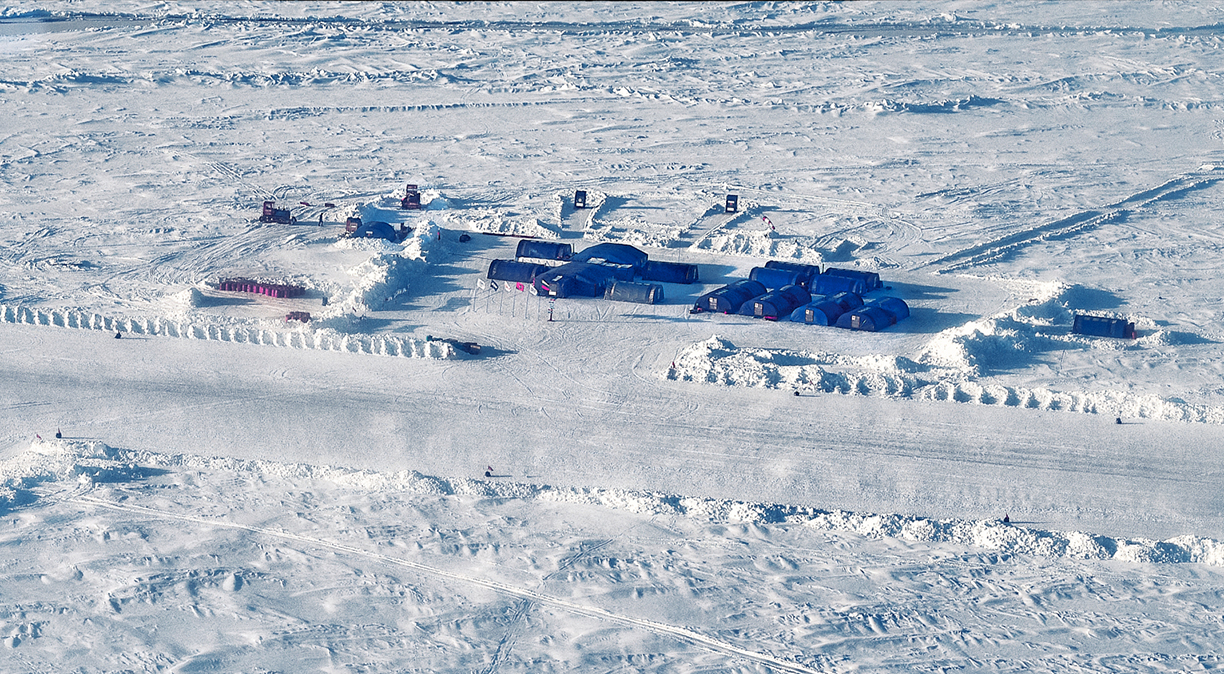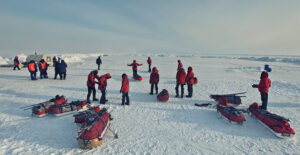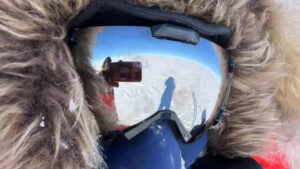An insider’s view of what’s happening with the famous North Pole station
Next month, for the first time since 2018, tourists will come to the Barneo ice station. From there, they will ski or fly to the North Pole itself. But the experience will be very different this year.
This temporary camp on the sea ice about one degree of latitude from the North Pole has operated for about 25 days in April since the early 1990s. Planes reached Barneo via Longyearbyen, on the Norwegian territory of Svalbard. During this time, a United Nations of adventure tourists have skied, run, parachuted, and sipped champagne at the North Pole. The only things they had in common were a fascination with the polar regions and a lot of money.
Although internationally run for part of its lifetime, most logistics and workers have always come from Russia. The problems began in 2019 when a Ukrainian-owned plane was denied permission to land on Barneo’s airstrip because of the growing tensions between Russia and Ukraine. Then came COVID-19, followed by Russia’s invasion of Ukraine. Since then, Norway has not permitted Russian planes to land in Longyearbyen. With politics and climate change, many wondered whether Barneo’s time had passed.
The Russian route
But surprise, surprise, Barneo is running this year. Although Swiss pharmaceutical billionaire Frederick Paulsen still owns the operation, the Russian presence will be much more noticeable. That is because everyone going to the ice station must travel through Russia and spend several days there. Not exactly a mouthwatering prospect for Westerners these days.
Apart from the political/moral issue, many logistical problems remain. Flights to Russia are limited; you may have to route via Serbia or the Middle East. Most travel insurance will be invalid because Western countries formally advise against travel to Russia. There is typically little or no consular support. Credit and debit cards, even PayPal, won’t work in Russia because of sanctions. It’s illegal to bring in foreign currency. How do you pay for anything?
Currently, the Barneo company in Switzerland will buy everything within Russia — flights, hotels, food, and incidentals. Presumably, they will also provide roubles as pocket money.

Two visas needed
Another tricky issue this year: One must secure a multi-entry visa. A single one won’t do the job. The first visa will be used to enter Russia and exit the country at Krasnoyarsk on the way to Khatanga (still in Russia but too small to have a customs office). The second visa is necessary to re-enter Russia on the way back to Krasnoyarsk after the Barneo experience.
So once visitors have officially exited Russia in Krasnoyarsk, they will still spend two days on Russian territory without a valid visa while visiting Khatanga and the refueling/pit stop at Severnaya Zemlya. The same on the way back.
It is also a significantly greater investment of time. The new route to Barneo might shave a few minutes off for those coming from the Far East. For the rest, particularly those jetting in from Europe, it’s a marathon, not a sprint. It’s a few hours from central Europe to Moscow, then a five-hour flight from Moscow to Krasnoyarsk. It’s another five-plus hours from there to Barneo.
The old flight from Longyearbyen to Barneo took just two hours.
In other words, with the Svalbard model, tourists could make a round trip to the North Pole in less than 24 hours. Via Krasnoyarsk-Khatanga, it will take at least three days, weather permitting.
No guns allowed
A last change affects the polar bear protection needed for the adventurers. Polar bears are rare near the North Pole, but they can show up anywhere, anytime. Until now, every group’s guide carried a firearm, but Russia has a strict “no guns” policy for foreigners. And lest you think you can simply rent a Kalashnikov like you could rent a firearm in Longyearbyen until recently, think again. Russian law states that no one, not even Russians, can rent guns. Instead, an armed Russian official will accompany each group.
Still interested? There are reportedly four Americans, one Brit, and some Indians and Chinese. In all likelihood, it will be a very quiet year, compared to the hundreds who used to show up here.
Building Barneo
The action begins at the end of March when MI-8 helicopters look for a viable ice floe near the North Pole. Once this elusive piece of frozen real estate is secured, an Ilyushin-76 will fly over the chosen spot. From 600 meters up, it will disgorge bulldozers, fuel, and construction materials by parachute. Then the construction team, strapped to tandem parachutes and possibly questioning their life choices, will leap from a frigid height of 3,000 meters to join the materials on the ground.
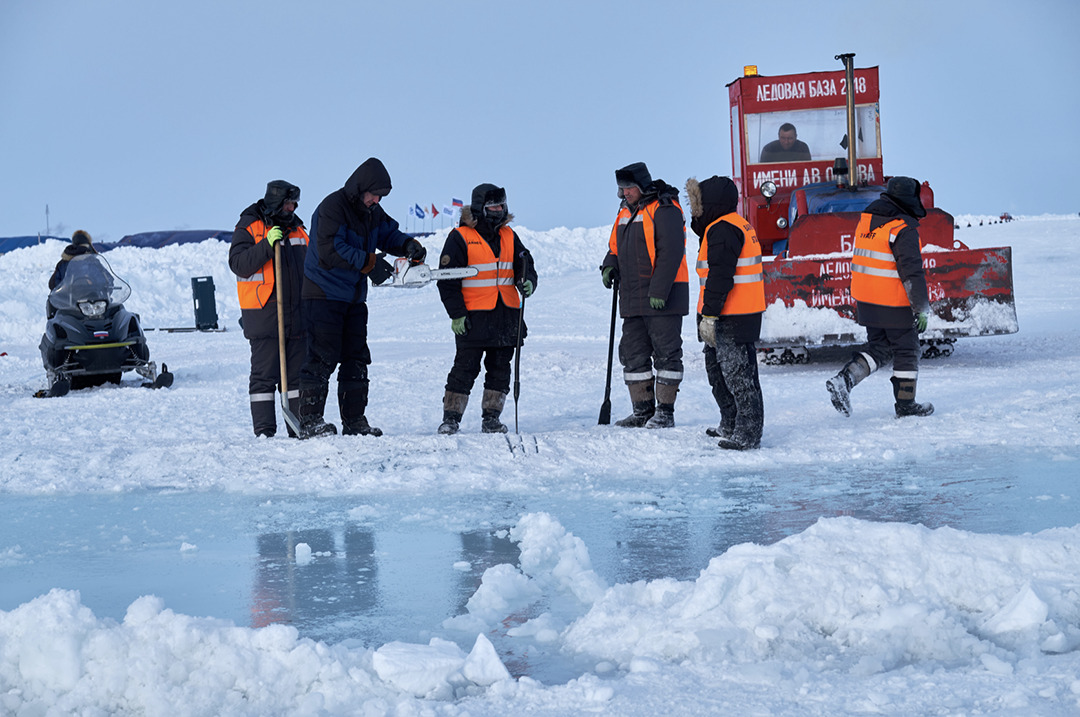
Some Russian workers repair the airstrip at Barneo. Photo: Galya Morrell
Soon, a runway begins to take shape on the world’s chilliest construction site. This 1,200m ribbon of ice can welcome a big AN-74 aircraft.
North Pole Marathon
At least one group of Last Degree skiers will leave the Siberian city of Krasnoyarsk in early April. The athletes planning to run a marathon at Barneo are not far behind them. They leave Krasnoyarsk for Khatanga on April 8.
This marathon idea began when Richard Donovan, an Irish ultra-marathoner, ran 42km around the Pole solo in 2002. He subsequently founded what he called the North Pole Marathon. It became the most visible event of the Barneo season. The race didn’t take place at the Pole itself for logistical reasons, but the runners did fly out to see it later.
At $16,000 in 2018, it was also the cheapest way to visit the Pole. A lot cheaper, anyway, than the champagne flights, which cost $25,600. (Today, it is $24,000 vs $31,000.)

The North Pole Marathon has a new organizer this year. Photo: Galya Morrell
Still, people from all walks of life came. There were blind and wheelchair participants, cancer patients, wounded soldiers, and many others. I recall the first Aborigine from Australia and a young runner from Greenland who grew up in an orphanage. Roughly 65 people took part every spring.
After the marathon’s cancellation in 2019, Donovan assigned the event’s trademark name to a company called Runbuk. Its owners, Oliver Wang and Renna Hu, will operate the 2024 North Pole Marathon for about 20 runners. The race director is Ted Jackson of the UK.
By April 15, a second planeload of Last Degree skiers may or may not materialize. Meanwhile, many would-be visitors are currently scrambling to secure their Russian visas.
Barneo’s simple beginnings
How did all this come about? Not just this latest incarnation of Barneo but the idea of Barneo itself?
I’ve crisscrossed the Russian Arctic more times than I care to remember, all the way back to the Soviet era. My experiences in Khatanga during the 1980s were a far cry from the Barneo expeditions of today. Life in Khatanga was anything but easy. The town was a melting pot of indigenous peoples and newcomers, all united by a struggle against the elements.
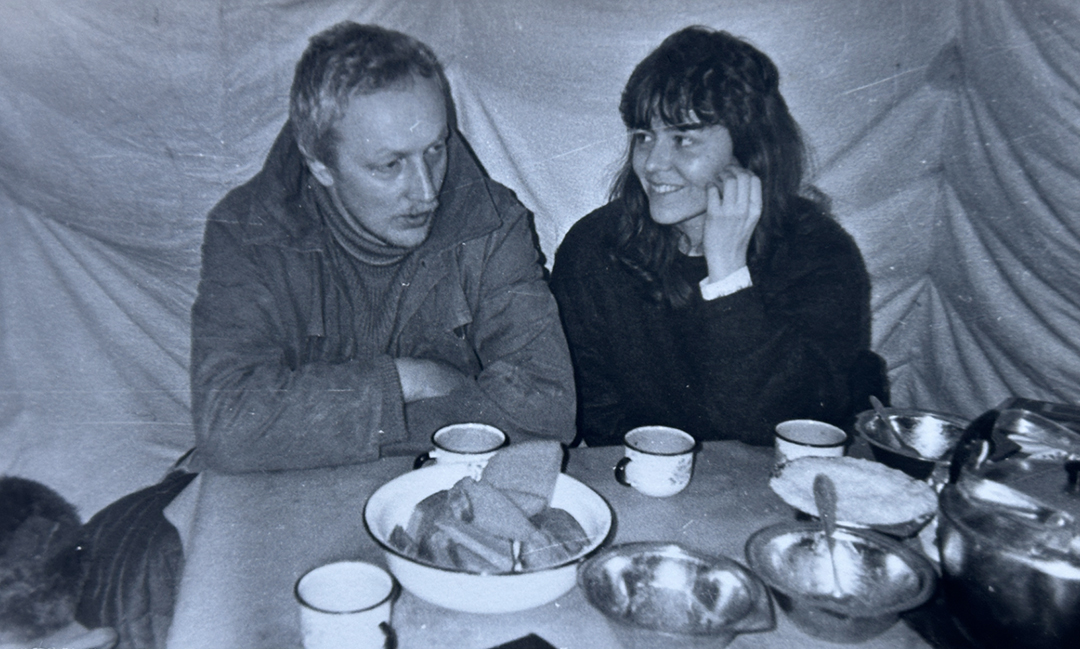
The author, right, interviews a scientist at an old Soviet ice station. Photo: Galya Morrell
I’ll never forget one flight from Krasnoyarsk to Khatanga, huddled for warmth under cages of live chickens in the freezing bosom of a cargo plane, only to emerge on the other side covered in…well, let’s just say it wasn’t snow.
Back in those days, the North Pole received zero attention. There was no Barneo and no reason to think about the North Pole. But its precursors had been on the Arctic Ocean ice for decades. These were the floating Soviet research stations, which have been around since 1937. They were called Severny Polyus-1 (North Pole–1), SP-2, all the way up to the latest, SP-41.

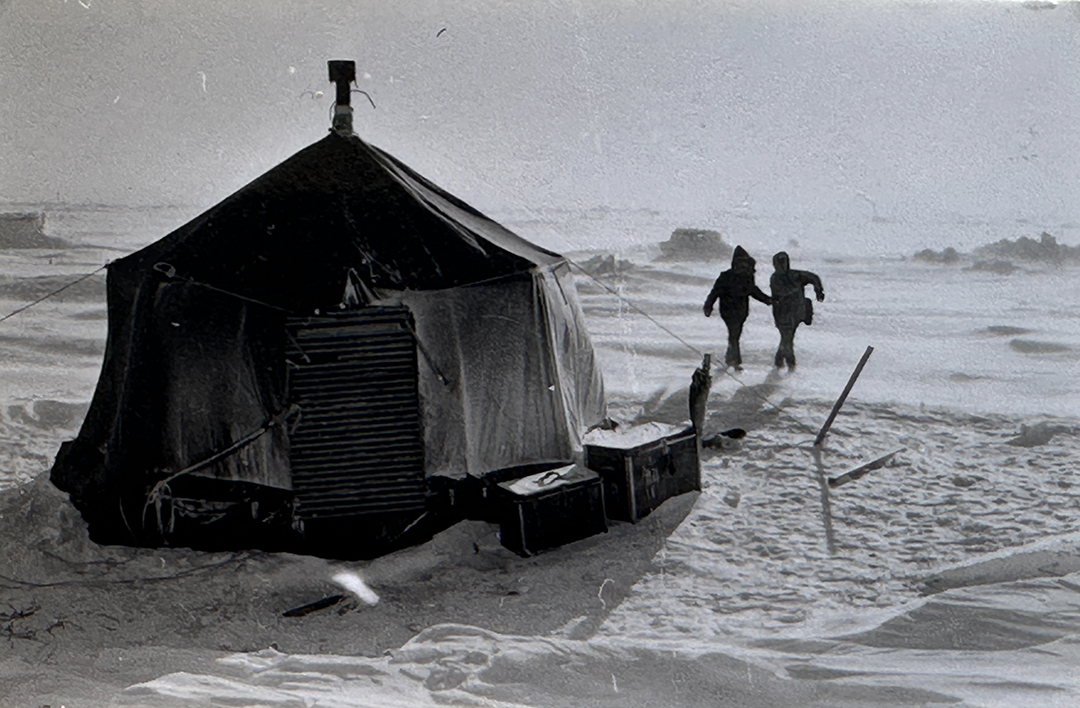
A spartan world: Soviet research camps from the 1980s. Both: Galya Morrell
Polar science
Picture a group of scientists huddled on a chunk of ice, living in what could generously be called spartan conditions, with an outhouse that became a skating rink come spring. Apart from hard living, sometimes things didn’t go as planned. SP-40 met an inglorious end in 2013 when its ice floe broke up unexpectedly, forcing an emergency evacuation of the crew to Severnaya Zemlya.
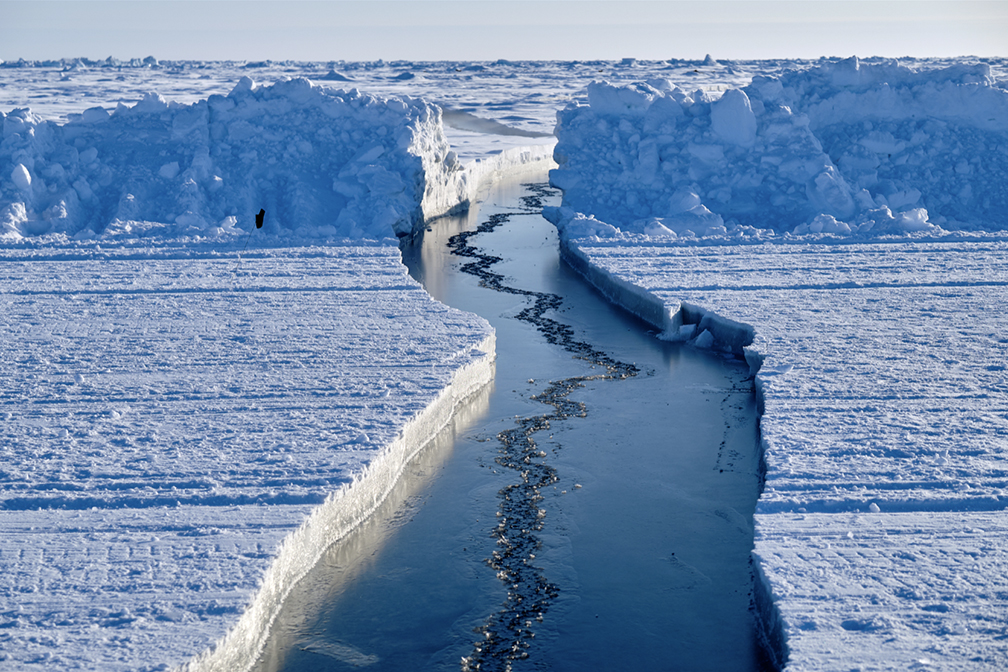
A lead forms in the sea ice in the middle of Barneo’s airstrip. Photo: Galya Morrell
The collapse of the Soviet Union in 1991 turned life in the Arctic on its head. Jobs disappeared, people left, and Khatanga’s future was uncertain.
The mammoth man gets an idea
But in the early 1990s, Bernard Buigues, a French explorer and mammoth fossil hunter, credited for discoveries of the Yukagir mammoth and Lyuba, the 42,000-year-old baby mammoth featured in the National Geographic documentary Waking the Baby Mammoth, found time to build the very first Ice Camp Barneo.
Bernard and another French explorer, Christian de Marliave, developed a base in Khatanga to launch high-latitude expeditions.
In that hyper-inflationary era, prices were surreally cheap in Russia if you could pay in Western currency. The cost of building a landing strip was roughly equivalent to two bags of potatoes. The price for skiing the last degree to the North Pole? About $9,000. By today’s standards, that sounds almost quaint.
So Bernard Buigues and Christian de Marliave began organizing expeditions out of northern Russia at a modest cost that today would amount to the equivalent of a small yacht. They attracted all sorts, including skydivers leaping from the cavernous belly of an Il-76 cargo plane from 4,000m up. The camp was an exercise in minimalism, erected not out of a desire for profit but from a love of the Arctic.
The story of that first Ice Camp Barneo in the early 1990s is largely forgotten today, partially for political and business reasons and partly because it existed in the pre-internet era.
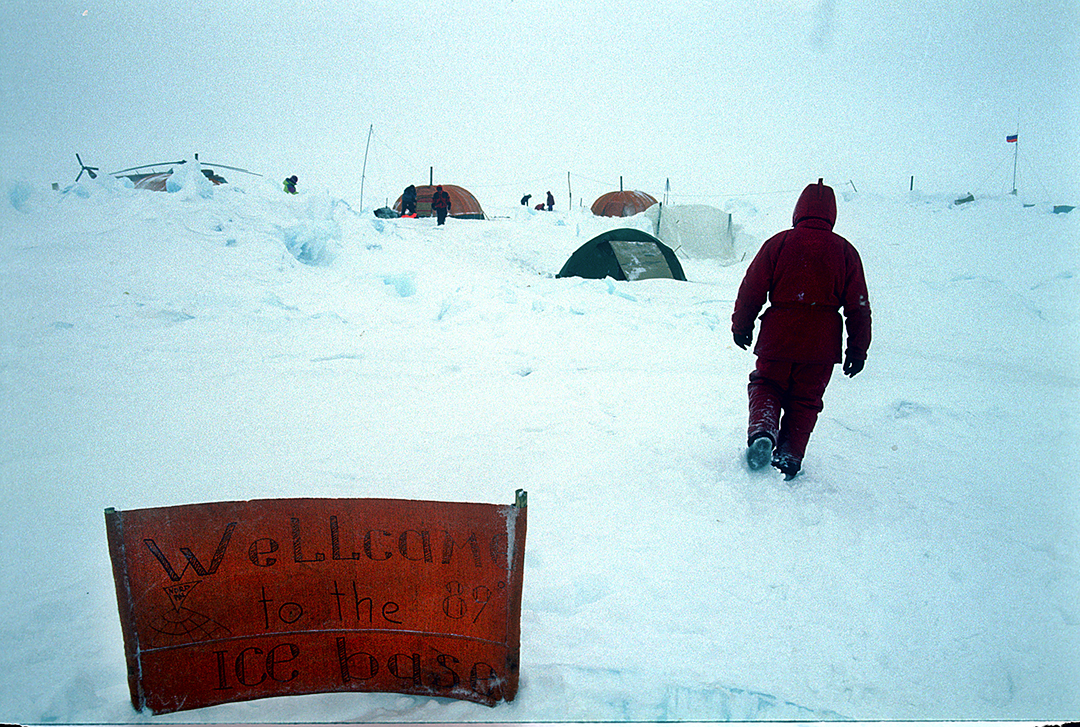
The first Barneo, 1991. Photo: Galya Morrell
Changing times
The Latitude 90° and Serpolex Ice Camp Barneo operation, as it was known, chugged along smoothly until 2002, when the tide turned. Buigues and de Marliave, more focused on paleontology and less on money and politics, found themselves edged out by the Russian polar establishment.
Alexander Orlov, a former polar navigator who had successfully navigated his way into entrepreneurship, took the reins. Unlike the French duo, Orlov’s interests aligned well with the Russian state. And so, the Khatanga route, once the symbol of the pioneering spirit and adventure on a budget, has come full circle.
The new Barneo
The abrupt cancellation of season 2019 was awkward and painful. COVID-19 killed the 2020 and 2021 seasons. COVID restrictions lingered in 2022, but limitations on Russian planes in European airspace were probably the biggest factor.
In March 2023, just as everyone was gearing up for the grand opening of post-COVID Barneo, the Norwegian aviation authority, Luftfartstilsynet, stepped in. They outlawed the AN-74 flights out of Longyearbyen, supposedly on environmental grounds. They also nixed some helicopter landings for a Tom Cruise flick.
However, the brains behind Barneo had been scrambling for a Plan B for several years. In 2019, Krasnoyarsk governor Aleksandr Uss announced a project to transform Khatanga, a settlement of about 2,500 on the Taymyr Peninsula in Siberia, into a new transit hub to the North Pole.
The Mammoth Inn
At the same time, Frederick Paulsen renovated a Soviet-era hotel in Khatanga into a luxury stopover for the polar-bound elite. Called the Mammoth Inn, its motto is, “Keep Calm and Go Arctic!” whatever that means. The Mammoth Inn publicizes itself as “the only hotel in the world located this close to the North Pole.”
(Alas for truth in advertising, that’s not quite correct: Khatanga is located at approximately 72˚N. There are several hotels further north — in Longyearbyen; Grise Fiord, Canada; Qaanaaq, Greenland, among others.)
Yet the Mammoth Inn is apparently the hottest ticket in town for April. Most rooms are booked solid. You’re promised an array of culinary delights, although not mammoth — at least, not yet. Instead, guests will feast on “traditional venison, northern white fish, wild mushrooms and other native plants…”
And then there’s Mamont vodka, a creation of Frederick Paulsen. This vodka, they say, passes through Siberian birch charcoal and gets a cedar nut finish. It is served cold in a bottle shaped like a mammoth’s tusk at the hotel bar.
Cultural entertainment in Khatanga includes visits to “airport, seaport, and other cultural sites,” a list that manages to be both vague and oddly specific. Then there’s the Mammoth Museum, which is worth the visit, because it features some of Bernard Buigues’ mammoth finds.
Trial run in 2023
When Norway canceled landings in Longyearbyen in March 2023, the Barneo crew took it in stride. The tourist season may have been canceled, but with both Khatanga and the Mammoth Inn ready, they decided to take special visitors on a trial run to Barneo.
April saw six flights zip between Khatanga and Barneo, ferrying a VIP list of Frederick Paulsen’s pals, plus others. There were half a dozen Last Degree skiers, then a second batch of adventurers, and then the crew of nearby Severny Polyus-41. It seemed to go well, and thus work began to organize Barneo’s return in 2024.
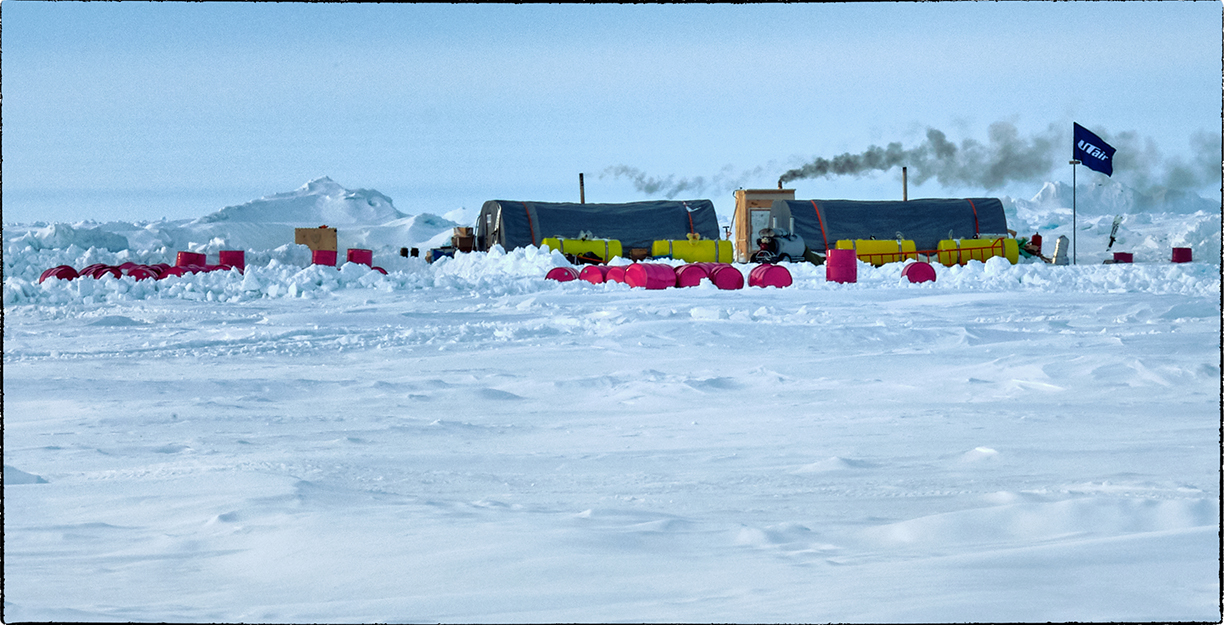
Barneo. Photo: Galya Morrell
The North Pole, which is a purely mathematical concept, has been reached by dogsled, dirigible, airplane, nuclear submarine, snowmobile, motorcycle, nuclear icebreaker, ultra-light aircraft, helicopter, parachute, and on skis and snowshoes. Over the centuries, dozens have died trying to get there.
But for all the bragging rights that come with reaching the Pole, there’s a sobering reality: You can reach the Pole but you can’t stay on it. It’s always drifting south with the ice. Perhaps, in the end, that’s what makes the North Pole so alluring: the knowledge that, no matter how hard we try, it always remains beyond our grasp.
